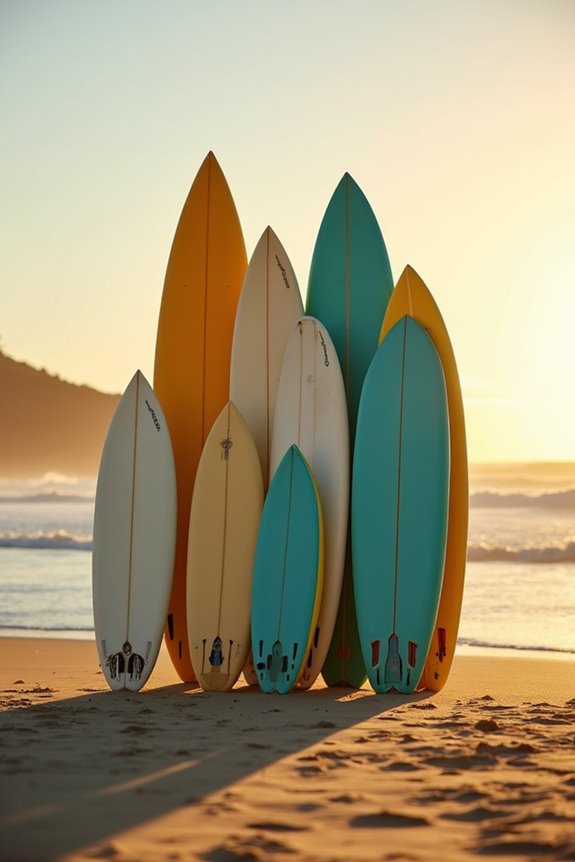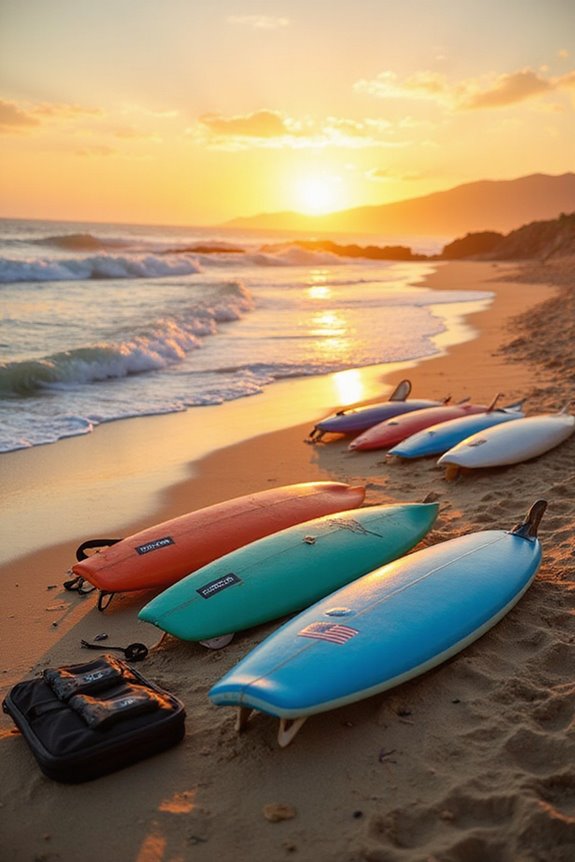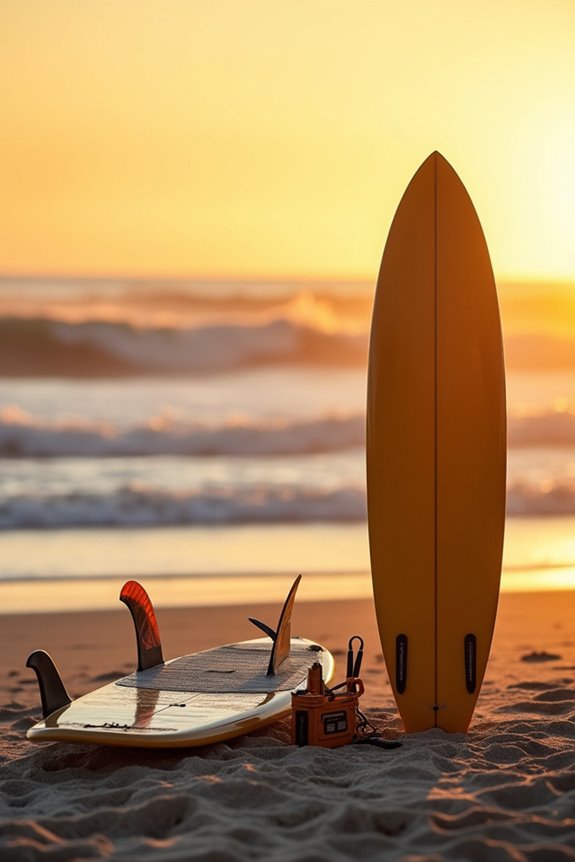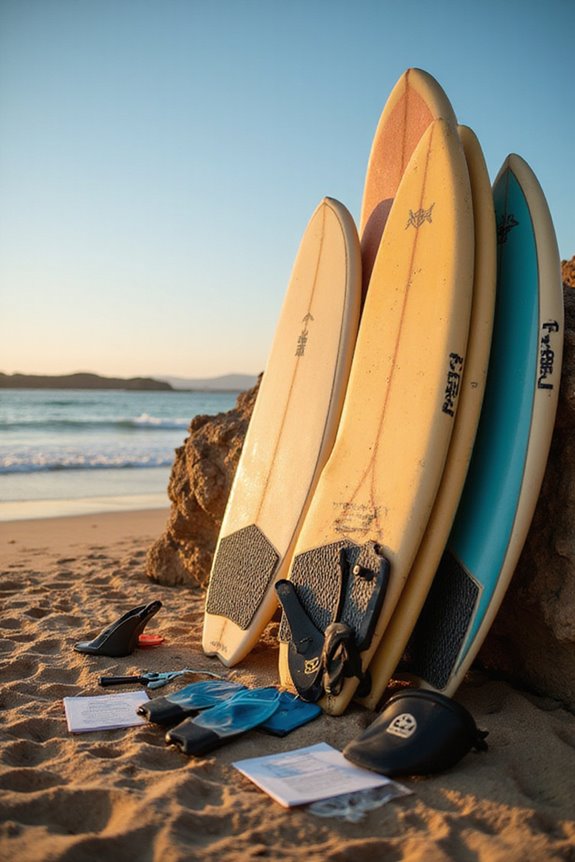To handle surfing in mixed-ability groups effectively, we should focus on understanding dynamics, structuring lessons, and ensuring safety. First, we promote strong group identity and inclusivity through clear communication. Next, we break lessons into warm-ups, skill practice, and cool-downs to scaffold learning. Prioritize safety by evaluating conditions, maintaining low instructor-to-participant ratios, and educating on wave etiquette. By prioritizing skill development and fostering mutual support, we enhance confidence and enjoyment in the water. More detailed strategies await.
Key Takeaways
- Foster a strong group identity to enhance motivation and belonging among participants of varying skill levels.
- Implement structured lessons with segments to cater to different abilities, ensuring everyone progresses effectively.
- Prioritize safety by assessing ocean conditions, educating on hazards, and maintaining a low instructor-to-participant ratio.
- Encourage peer support and communication to build mutual respect and inclusion within the group.
- Focus on skill development through tailored techniques and off-water training to accommodate all participants’ needs.
Understanding Mixed-Ability Dynamics
When we engage in mixed-ability surfing groups, we create an environment that promotes positive social interactions among participants with varying skill levels. This setting fosters a strong group identity, where shared experiences in the water enhance our sense of belonging and motivation.
Effective communication styles become essential as we navigate different skill levels. Sensitivity and patience are vital to prevent feelings of exclusion or frustration. By supporting one another, we can improve social outcomes and emotional regulation. Additionally, understanding perceptions of water safety helps maintain inclusivity, ensuring everyone feels secure while participating. Furthermore, being aware of strong currents is crucial for keeping all surfers safe in a mixed-ability setting.
Through collaboration and open dialogue, we can encourage peer support and build a cohesive group dynamic that benefits all members, regardless of their individual abilities.
Structuring Effective Group Lessons
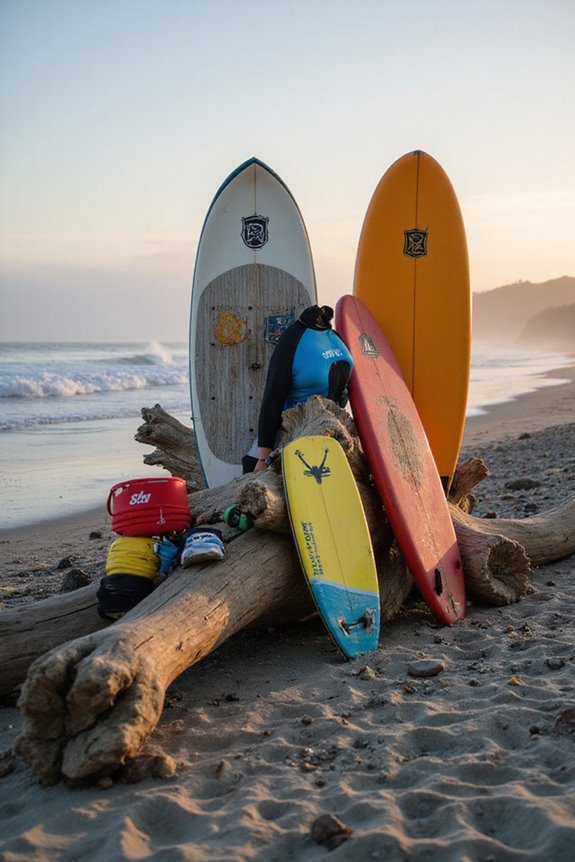
Structuring effective group lessons for mixed-ability surfing requires careful planning to confirm all participants can learn and progress at their own pace. We should divide the lesson into segments: warm-up, basic skills, standing techniques, and cool-down. This lesson segmentation helps accommodate various abilities.
Next, we can use demonstrations and practice cycles for key skills like paddling and popping up, allowing learners to scaffold their knowledge progressively. By incorporating semi-circle instruction, we engage all participants while promoting observational learning.
Additionally, maintaining group motivation is essential; we can encourage peer support and share tips, fostering a collaborative environment. Finally, we must monitor group dynamics and adjust activities as needed to confirm everyone stays engaged and supported. It’s also beneficial to include experienced instructors in the lesson structure, as their guidance can significantly enhance the learning experience for all skill levels.
Prioritizing Safety and Wave Etiquette
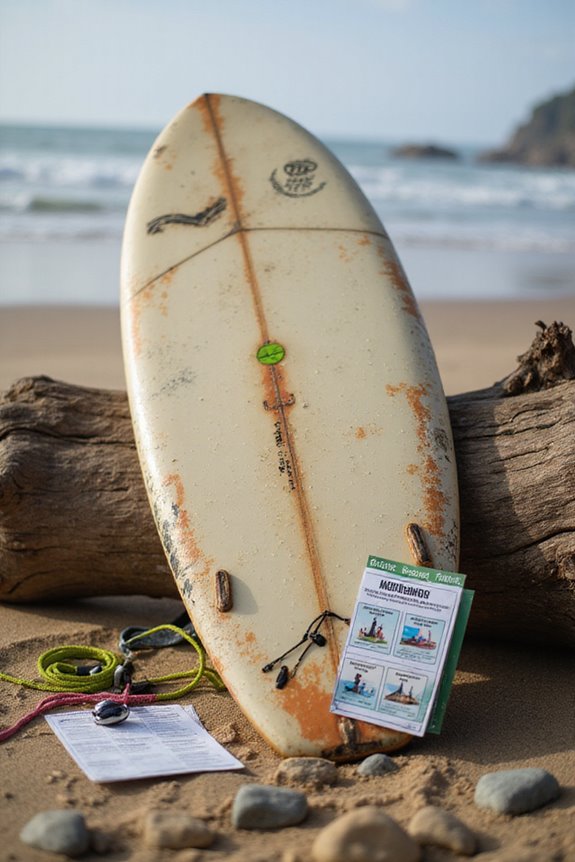
Prioritizing safety and wave etiquette is vital for guaranteeing a positive surfing experience for all participants, especially in mixed-ability groups. We must assess ocean conditions, use safety gear, and maintain a low instructor-to-participant ratio. Educating everyone on hazards and implementing clear safety protocols, such as rescue readiness and communication signals, is essential.
For wave communication, we should instruct surfers on right-of-way rules, emphasizing that the surfer closest to the peak has priority. Non-confrontational methods, like hand signals, help convey intentions, while promoting patience guarantees that beginners feel included. By fostering mutual respect among all surfers, we can create a supportive atmosphere that enhances everyone’s enjoyment and safety in the water. Additionally, understanding surfboard types can help participants choose the right equipment suited for their skill level and the conditions they are surfing in.
Techniques for Skill Development
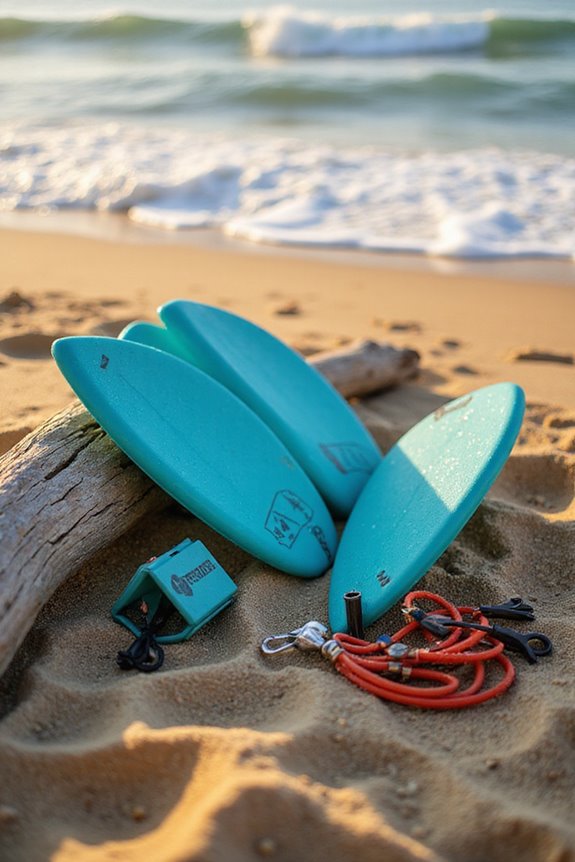
Developing surfing skills in mixed-ability groups requires structured techniques that cater to various experience levels. We can focus on key areas such as board control and wave positioning. Adjusting foot placement helps modulate speed and direction, while maintaining gaze down the line enhances stability.
Paddling techniques are vital; powerful strokes with an arched back increase propulsion. Incorporating balance training off the water, using tools like balance boards, supports overall stability.
Wave awareness and surf forecasting are essential for skill progression. By learning to read waves and studying surf conditions, we can improve maneuver execution. Additionally, utilizing a surf training aid can help beginners enhance their pop-up technique and build confidence in the water. Documenting our experiences and adapting practice based on different wave types will further refine our abilities in diverse environments.
Psychological and Social Considerations
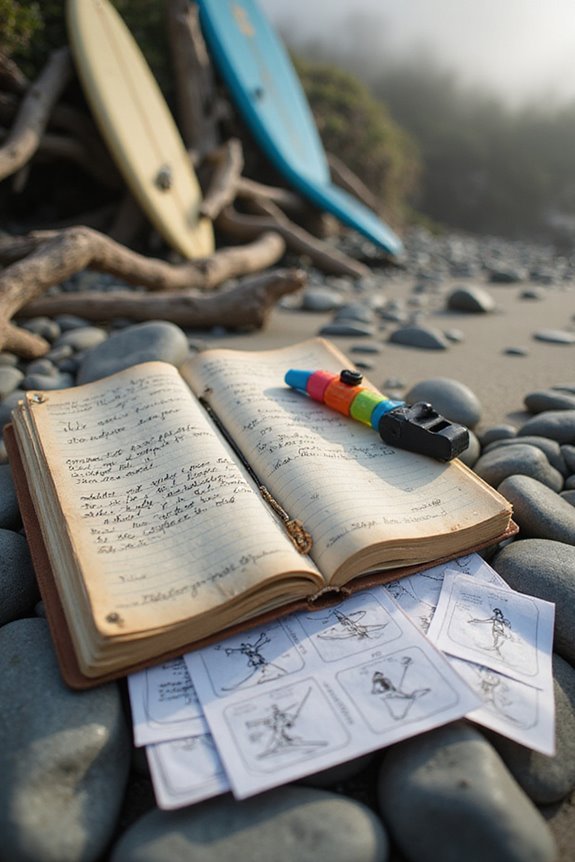
While surfing in mixed-ability groups, we can see significant psychological and social benefits that enhance the experience for all participants. These sessions foster emotional resilience, as individuals face challenges together and learn to manage their emotions. The shared environment encourages social interactions that build mutual respect, enhancing feelings of inclusion among all surfers.
As we navigate the waves, we gain confidence and self-efficacy through mastery of skills, which positively impacts our mental health. Additionally, supportive dynamics within the group allow us to practice communication and empathy, essential for developing strong social bonds. By engaging in shared experiences, we reinforce our connections, creating a community that values each member’s contributions, regardless of their abilities. Furthermore, local surf schools offer lessons for beginners tailored to mixed-ability groups, ensuring that everyone can enjoy the surf regardless of their skill level.
Logistical Planning for Surf Sessions
When planning surf sessions for mixed-ability groups, it’s essential to take into account various logistical factors to guarantee a safe and productive experience for everyone involved. Effective session logistics begin with proper group organization; we should maintain a maximum coach-to-student ratio of 1:5 for intermediates and 1:4 for advanced surfers.
Each subgroup needs a dedicated instructor, especially in different surfing zones. We also need to select beach breaks with waves no higher than 1.5 meters for beginners, ensuring safety for all.
High-visibility vests for instructors and participants will enhance safety and visibility in the water. Additionally, ensuring that all participants are equipped with appropriate winter wetsuits can significantly improve comfort and thermal insulation in colder waters, especially those rated for water temperatures below 53.6F. Finally, we must always monitor conditions and reinforce safety protocols to facilitate smooth, enjoyable sessions for everyone.
Strategies for Peer Learning and Mentorship
Incorporating peer learning and mentorship into our surf sessions can greatly enhance skill development and foster a sense of community among participants. By leveraging experienced surfers to mentor less skilled peers, we create a supportive environment that encourages collaboration and knowledge exchange.
Key Strategies:
- Structured Activities: Pair advanced and novice surfers for small group tasks, focusing on technique and safety.
- Defined Roles: Establish clear responsibilities for mentors to guarantee accountability and personalized support.
- Real-Time Feedback: Encourage mentors to provide immediate corrections, enhancing learning and safety.
- Emotional Safety: Promote a non-competitive atmosphere where participants feel comfortable experimenting and taking risks.
Through these strategies, we can maximize mentorship benefits while fostering collaborative learning and emotional well-being.
Frequently Asked Questions
What Should I Bring to a Mixed-Ability Surf Session?
When planning a mixed-ability surf session, we should pack appropriate surf gear and essential safety equipment, including soft-core boards, leg ropes, helmets, life vests, and communication devices to guarantee everyone’s wellbeing and enjoyment in the water.
How Can I Improve My Surfing Outside of Group Lessons?
Imagine catching that perfect wave, feeling unstoppable. To enhance our surfing outside group lessons, we should prioritize personal practice through solo sessions, exploring diverse conditions, refining techniques, and building confidence to elevate our skills dramatically.
Are There Specific Surfboards Recommended for Different Skill Levels?
When choosing surfboards, we should consider skill levels. Beginner boards offer stability for learning, while advanced boards focus on maneuverability and speed. Selecting the right board helps us improve our surfing experience and skills effectively.
How Do I Choose the Right Surf Spot for Mixed-Ability Groups?
When choosing a surf spot for mixed-ability groups, we should prioritize gentle surf conditions and assess group dynamics. Mellow waves and ample space enhance safety, ensuring everyone enjoys their time on the water together.
What Are Common Mistakes to Avoid in Mixed-Ability Surfing?
As we paddle out like knights seeking waves, let’s avoid common mistakes in mixed-ability surfing. Prioritizing surf etiquette and adhering to safety protocols keeps us all riding smoothly while building confidence together in the water.

